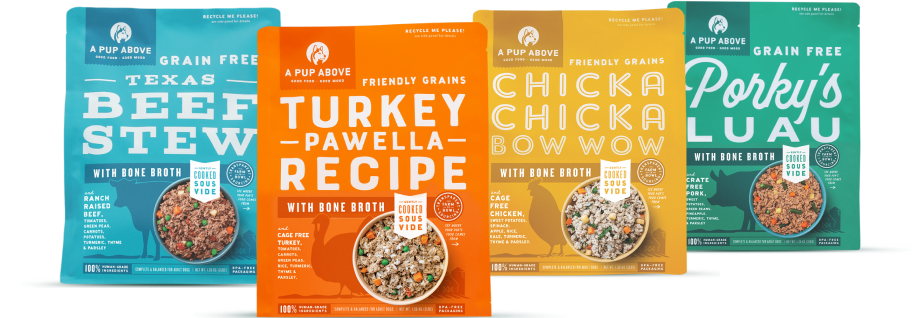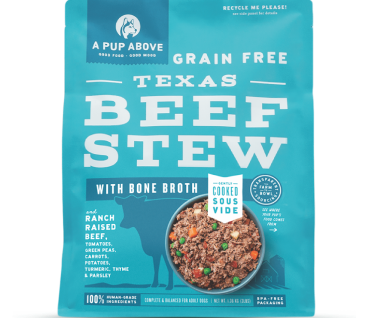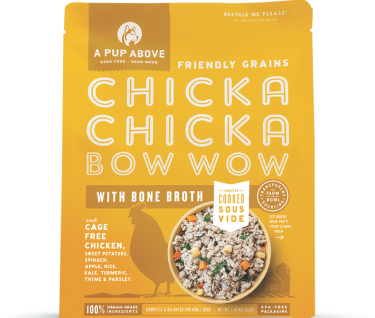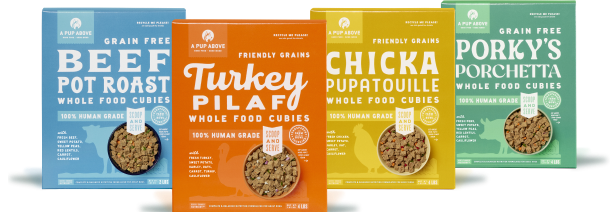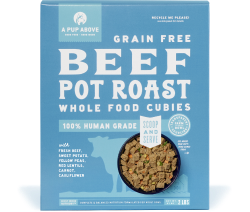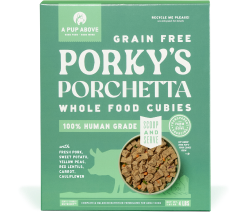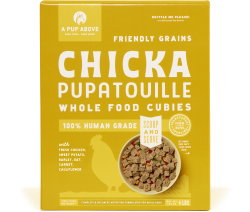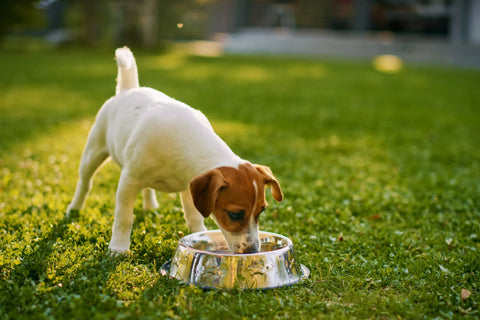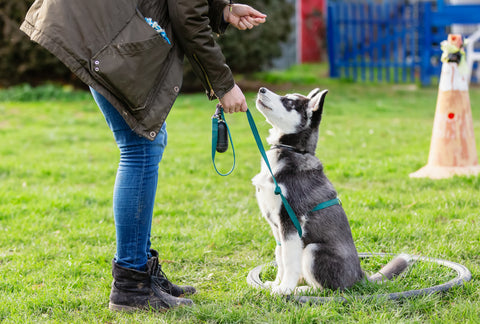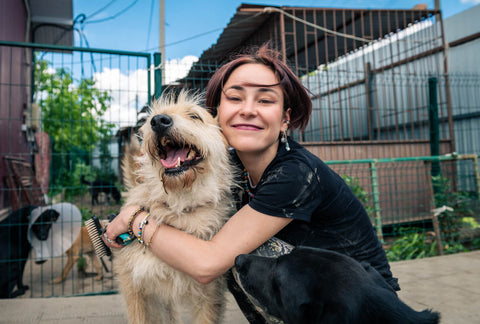
Changing your dog's diet isn't something you do on a whim — it's an act of care that reflects your commitment to their health and happiness.
At A Pup Above, we understand that whether you're responding to your dog's changing nutritional needs or simply aiming to enhance their diet with nutritious, human-grade meals, the process requires thought, patience, and knowledge.
This guide is designed to walk you through safely transitioning your dog to a new food, ensuring their adjustment is as smooth and comfortable as possible.
Why Is It Important to Switch Dog Food Gradually?
Gradually switching your dog's food is a smart move for a few key reasons:
- Digestive Comfort: Sudden changes in diet can lead to digestive upset. A gradual transition helps your dog’s digestive system adjust to new ingredients, reducing the risk of diarrhea or vomiting.
- Nutrient Absorption: A slow switch ensures your dog's body can properly adjust to and absorb the new nutrients effectively.
- Flavor Adaptation: Gradually introducing new flavors allows your dog to become accustomed to the taste and texture of their new diet, increasing acceptance.
When Should You Consider Changing Your Dog's Food?
There are several occasions when changing your dog's food might be beneficial or necessary:
- Life Stage Transitions:Puppies, adults, and seniors have different nutritional requirements. Adjusting their diet as they age ensures they get the right balance of nutrients.
- Health Issues: Certain health conditions may require dietary adjustments. For example, a pup with diabetes may need a diet lower in carbohydrates.
- Activity Level Changes: A surge in activity or a shift to a more sedentary lifestyle can alter your dog's caloric and nutritional needs.
- Food Allergies or Sensitivities: If your dog develops allergies or sensitivities to certain ingredients, switching to a diet that doesn't include those triggers is crucial.
How To Switch Dog Food Safely: A Step-by-Step Guide
Switching your dog’s food is an important decision that can significantly impact their health and well-being. Here’s how to ensure the transition is as smooth and beneficial as possible, keeping their tail wagging all the way through.
Chat With Your Vet
First things first: have a heart-to-heart with your vet. Every dog is as unique as our recipes, and your vet can help tailor the switch to suit your dog’s health needs. It's like choosing between our fresh food and dry food — each delicious, each nutritious, but one might just hit the spot better for your pup.
Choose the New Food
Now, for the fun part — picking out the new food. Consider what makes your dog's tail go wild, their health needs, and any specific nutritional requirements. Our range, from Porky’s Luau to Chicka Chicka Bow Wow, offers something special for every pup’s palate and nutritional needs.
The Mixing Bowl Technique
Imagine you’re baking a cake. You wouldn’t throw all the ingredients in at once, right? The same goes for switching dog food.
Start with a mix that’s mostly their current food, with a sprinkle of the new. Over the next seven to 10 days, gradually increase the new food while decreasing the old. It's a recipe for success.
Eyes on the Prize
As you navigate through this transition, keep a watchful eye on your pup. How are they handling the change? Any tummy upsets or changes in appetite? These signs will tell you if you need to adjust the pace of the transition.
Hydration Station
Just like us, changing diets can make dogs thirstier. Make sure there’s always a bowl of fresh water on standby. It's like the perfect drink pairing with a gourmet meal.
Stay the Course
If your pup’s digestive system were to send you a thank-you note, it would be for consistency. Give it some time once you’ve fully transitioned to the new food. Let their body adjust to the new nutrients and flavors.
Allergy Alert
Keep your eyes peeled for signs of food allergies or sensitivities — itchiness, digestive issues, or other changes. If something seems off, it’s back to the vet for a chat.
Enjoy the Journey
Switching your dog's food is a big deal, and it's okay to feel a mix of excitement and nervousness. Remember, you're doing this out of love, armed with knowledge and the best of intentions.
Troubleshooting Common Issues During a Food Transition
Navigating the switch to a new dog food can sometimes feel like you’re trying to solve a puzzle with your pup as the guiding piece. While we hope for smooth sailing, it's smart to prepare for a few waves along the way.
Here’s how to troubleshoot some common issues you might encounter during your dog’s food transition:
Tummy Troubles
It’s not unusual for dogs to experience a bit of digestive discomfort when trying new food. If your dog has loose stools or seems a bit gassy, ensure you’re transitioning slowly enough. If issues persist, a chat with your vet can help pinpoint whether an ingredient might not be sitting well with your dog.
Finicky Eaters
Some dogs might turn up their noses at new flavors or textures, making the transition a test of patience. If your dog is hesitating, try mixing in a bit more of the old food with the new, gradually adjusting the ratio. Sometimes, slightly warming the food can also make it more appealing by enhancing its aroma.
Increased Thirst
A change in diet, especially to a drier food, may lead to an increase in thirst. Ensure your dog always has access to fresh water. However, if you notice a significant spike in drinking that doesn’t settle, it’s worth consulting your vet.
Weight Changes
Keep an eye on your dog’s weight during the transition. A new diet might have different calorie contents, affecting their weight. Regular weigh-ins can help you adjust portion sizes to keep your dog in tip-top shape.
Behavioral Changes
Just like humans, dogs can be a bit out of sorts when their routine changes. If your dog seems more lethargic or unusually hyperactive, it could be a reaction to the new diet. Monitoring them closely and consulting with your vet can help determine if the food is the cause or if something else is at play.
How Do I Pick the Right Dog Food?
Choosing the right dog food is like selecting the perfect meal for a cherished family member — you want it to be nutritious, delicious, and just right for their health.
Here’s how to choose the right food for your pup:
- Understand Your Dog's Needs: Consider age, breed, activity level, and any specific health issues. Each detail helps tailor your choice.
- Ingredients Matter: Look for high-quality, wholesome ingredients. Our meals pack in nutrition with every bite, focusing on human-grade ingredients.
- Nutritional Balance: Ensure the food meets AAFCO guidelines for a complete and balanced diet, providing your pup with all the essential nutrients.
- Taste Test: Your dog’s preferences are key. A palate-pleaser like our Texas Beef Stew might just be the flavor that gets their tail wagging.
A Final Word
At A Pup Above, we're on a mission to fill your dog's bowl with nothing but the best. Switching your dog's food can seem daunting, but armed with the right knowledge and a sprinkle of patience, it's a journey toward a happier, healthier life for your dog.
Here's to the shared meals, moments, and memories that await on this delightful dietary adventure.
Sources:
How to Switch Dog Foods: Transitioning Your Dog's Diet | AKC
Is Your Puppy Drinking Enough Water? | American Kennel Club

